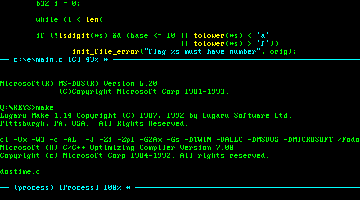DOS-specific Features |
|
 Epsilon's concurrent process buffer lets you run command-line
programs interactively in an Epsilon buffer, so you can use the full
power of Epsilon to prepare input or modify output. Sure, you'd
expect this kind of support in multi-tasking environments like
Windows, Unix or OS/2, but under DOS? Yet Epsilon has provided a
multitasking concurrent process under DOS since 1985. Don't be
fooled by similar-sounding claims from other editors--Epsilon is
the only editor for DOS with true multitasking.
Epsilon's concurrent process buffer lets you run command-line
programs interactively in an Epsilon buffer, so you can use the full
power of Epsilon to prepare input or modify output. Sure, you'd
expect this kind of support in multi-tasking environments like
Windows, Unix or OS/2, but under DOS? Yet Epsilon has provided a
multitasking concurrent process under DOS since 1985. Don't be
fooled by similar-sounding claims from other editors--Epsilon is
the only editor for DOS with true multitasking.
Under DOS, very big programs may not fit in memory along with your editor. That's why Epsilon can shrink to 10K when it runs your compiler or other program, to let even the biggest programs run. When Epsilon runs your program, you see it run, see any error messages, etc. You can even give the program input. After your program finishes, you're instantly back in Epsilon, with a complete input/output typescript. Some other editors use command line redirection to gather output, so you effectively compile blind. Running interactive programs is practically impossible. You must wait until the program finally exits to see any error messages. Epsilon does it right.
Epsilon has features that take advantage of all the capabilities of your machine. Under DOS, it fully utilizes EMS and XMS memory, as well as upper memory blocks between 640kb and 1 meg. Epsilon will use that space for the text you edit, as well as for its commands, making it fast to edit even very large files. If you've got files so big they don't fit in memory of any kind, Epsilon knows how to use temporary disk files to let you edit them anyway.
We know that screen space is valuable to you. The more of your program you can see at once, the easier it is to understand. So we don't reserve valuable screen space for scroll bars--Epsilon's scroll bars pop up when you move the mouse over them.
On EGA and VGA displays under DOS, Epsilon uses special techniques to display a graphical arrow cursor in "text mode." With no jumping block cursor, the mouse is easier to position, but Epsilon avoids the overhead of graphics mode, which can slow down screen updates.
Change screen sizes at the touch of a key. On standard VGA boards under DOS, switch between 25, 28, 35, 40, 43, and 50 lines to get just the right balance of legibility versus number of lines or characters. Epsilon automatically detects your VESA Super VGA board and can use any text modes it provides, such as 132 column modes. Epsilon also auto-detects the Ultravision TSR utility by Personics, and can use any additional modes that program provides. On VGA's under OS/2, Epsilon offers 25, 30, 43, 50, and 60 lines built-in, plus any additional Super VGA modes provided by your video board. If you've got an unusual display board, Epsilon can probably use its special display modes, too. Few other editors support the number of screen modes Epsilon supports. And often you have to exit the editor and restart it to switch screen modes. Not with Epsilon--a key press does it.
Take a look at Epsilon running in 132 column by 43 line mode on a typical SVGA board. Put that big monitor to use!